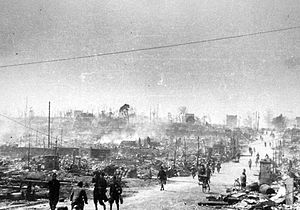
Back قصف طوكيو (10 مارس 1945) Arabic Bombezadenn Tokyo (10 a viz Meurzh 1945) Breton Bombardado de Tokio (10a de marto 1945) Esperanto بمباران توکیو (۱۰ مارس ۱۹۴۵) Persian Bombardement de Tokyo du 10 mars 1945 French Pengeboman Tokyo 10 Maret 1945 ID ടോക്കിയോയിലെ ബോംബിംഗ് (10 മാർച്ച് 1945) Malayalam တိုကျိုဗုံးကြဲမှု Burmese Бомбардировка Токио 10 марта 1945 года Russian Operation Meetinghouse SIMPLE
| Bombing of Tokyo | |||||||
|---|---|---|---|---|---|---|---|
| Part of the Bombing of Tokyo and Air raids on Japan during World War II | |||||||
 A road passing through a part of Tokyo which was destroyed in the 10 March 1945 air raid | |||||||
| |||||||
| Belligerents | |||||||
|
|
| ||||||
| Commanders and leaders | |||||||
|
Curtis LeMay Thomas S. Power | Shizuichi Tanaka | ||||||
| Units involved | |||||||
| XXI Bomber Command |
1st Anti-Aircraft Division 10th Air Division | ||||||
| Strength | |||||||
|
325 bombers (279 bombers over target) |
Approximately 638 anti-aircraft guns 90 fighter aircraft | ||||||
| Casualties and losses | |||||||
|
14 aircraft destroyed 42 aircraft damaged 96 aircrew killed or missing |
90,000 to 100,000 killed (most common estimates) Over one million homeless 267,171 buildings destroyed | ||||||
On the night of 9/10 March 1945, the United States Army Air Forces (USAAF) conducted a devastating firebombing raid on Tokyo, the Japanese capital city. This attack was code-named Operation Meetinghouse by the USAAF and is known as the Great Tokyo Air Raid in Japan.[1] Bombs dropped from 279 Boeing B-29 Superfortress heavy bombers burned out much of eastern Tokyo. More than 90,000 and possibly over 100,000 Japanese people were killed, mostly civilians, and one million were left homeless, making it the most destructive single air attack in human history. The Japanese air and civil defenses proved largely inadequate; 14 American aircraft and 96 airmen were lost.
The attack on Tokyo was an intensification of the air raids on Japan which had begun in June 1944. Prior to this operation, the USAAF had focused on a precision bombing campaign against Japanese industrial facilities. These attacks were generally unsuccessful, which contributed to the decision to shift to firebombing. The operation during the early hours of 10 March was the first major firebombing raid against a Japanese city. The USAAF units employed significantly different tactics from those used in precision raids, including bombing by night with the aircraft flying at low altitudes. The extensive destruction caused by the raid led to these tactics becoming standard for the USAAF's B-29s until the end of the war.
There has been a long-running debate over the morality of the 10 March firebombing of Tokyo. The raid is often cited as a key example in criticism of the Allies' strategic bombing campaigns. Many historians and commentators argue that it was not acceptable for the USAAF to deliberately target civilians, and other historians believe that the USAAF had no choice but to change to area bombing tactics given that the precision bombing campaign had failed. It is generally acknowledged that the tactics used against Tokyo and in similar subsequent raids were militarily successful. The attack is commemorated in Japan at two official memorials, several neighborhood memorials, and a privately owned museum.
- ^ "Legacy of the Great Tokyo Air Raid". The Japan Times. March 15, 2015. Retrieved March 25, 2018.
© MMXXIII Rich X Search. We shall prevail. All rights reserved. Rich X Search